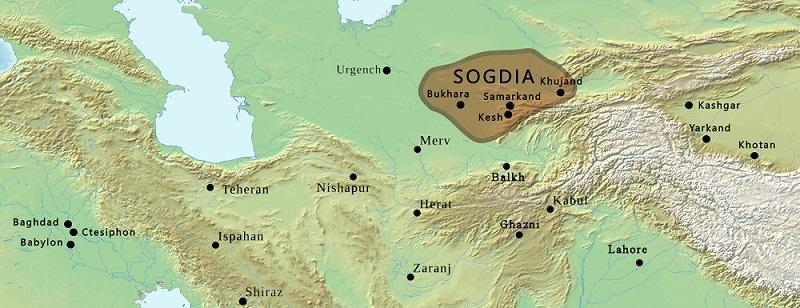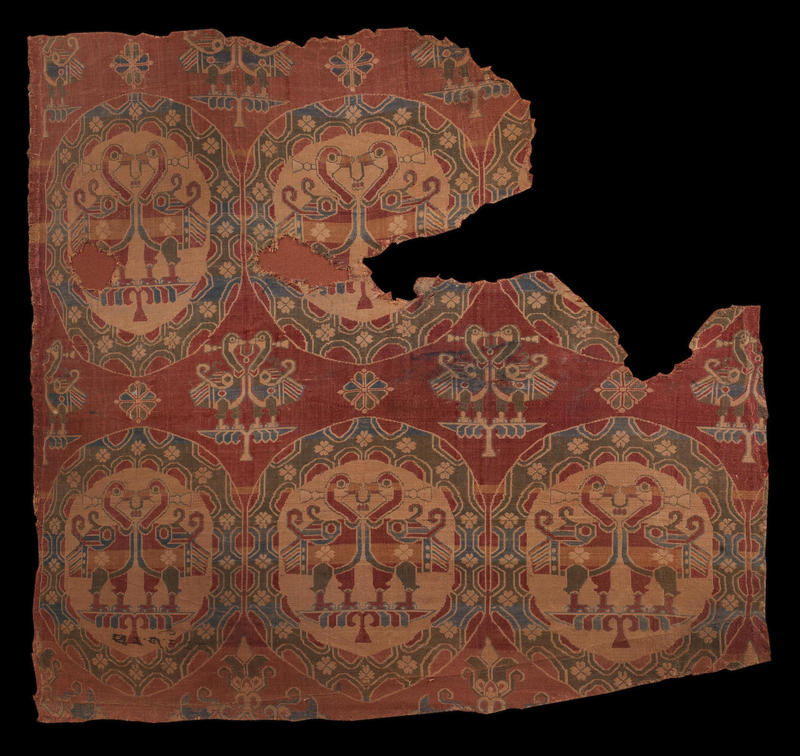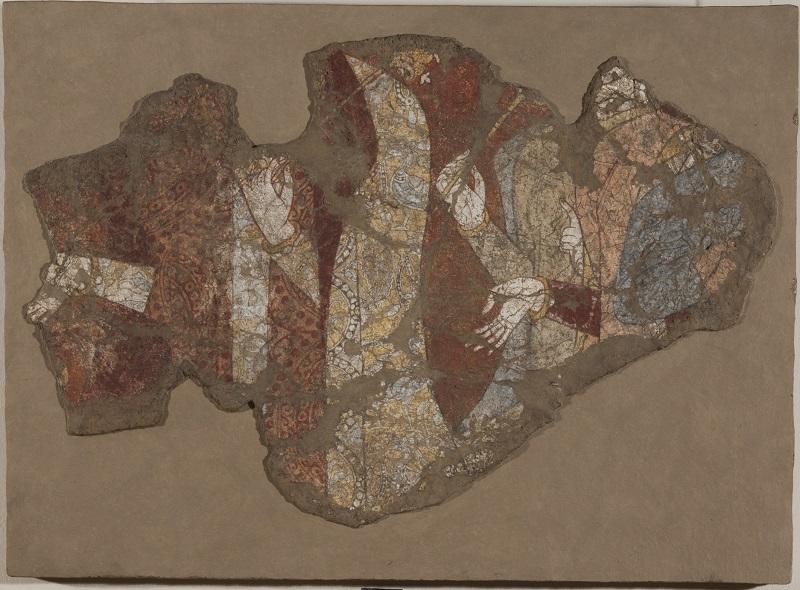The Invisible and the Visible: Sogdians and their Silks
The Invisible and the Visible: Sogdians and their Silks
by Zumrad Ilyasova, June 2025
Looking at the ruins of ancient Panjikent (Figure 1 above. April 2023, photo by the author), one might not immediately think of men and women dressed in fine, multicoloured silks banqueting in the reception halls at the centre of the buildings that once stood here. Between the 5th and 8th centuries, this town was inhabited by the Sogdians, an Iranian-speaking people from the territories of present-day southeastern Uzbekistan and northern Tajikistan (Map 1), known as masters of international trade.

Map 1: Map of Sogdiana. Panjikent is situated to the south-east of Samarqand, in the Zeravshan valley in modern-day Tajikistan. By DEMIS Mapserver, पाटलिपुत्र CC BY-SA 3.0, Wikimedia Commons, public domain.
To this day, researchers from around the world continue to debate the Sogdians’ exact role in the transmission of silk along the so-called Silk Roads, but their contribution to the spread of elite customs and fashions across Eurasia is beyond doubt. Here, we will not attempt to assess the extent of this contribution but, instead, explore what finds from Panjikent and its surrounding areas – a place hardly connected to the Eurasian trade networks – can tell us about tastes and fashions at a specific moment in the town’s history during the Arab invasion of Central Asia.
Silk merchants or silk weavers?
To work our way to this goal, we first need to survey the contexts in which the Sogdians are connected to silk production and distribution. The history of the Sogdians is fragmented and is largely reconstructed from sources outside Sogdiana. However, they have become less enigmatic over the past decades, thanks to the growing number of archaeological discoveries and the attention given to these people in recent exhibitions and wider public outreach (for example, Silk Roads at the British Museum and the online exhibition project The Sogdians. Influencers on the Silk Roads).
The earliest records of their commercial activities are preserved in the so-called Ancient Letters, a mail bag found by Aurel Stein near Dunhuang in West China. The letters in the bag were sent by Sogdians who had ventured far east in search of profit. Among them is a fascinating letter by a woman named Miwnay, who was abandoned in Dunhuang by her merchant husband and wrote about this to her mother. The letters never reached their intended recipients back home in Samarqand or their business partners in Luoyang, one of many cities in China where Sogdians established their diaspora communities.
Most textual sources on Sogdian traders come either from the Chinese imperial chronicle or from documents found in Turfan and Dunhuang. For example, the British Library paper fragment Or.11344/4, written in the Khotanese language in Brahmi script, mentions the purchase of woollen cloth from Sogdians. In addition to this textual evidence, there are many other forms of traces that Sogdian merchants left across Eurasia, for instance, the sandalwood with a Sogdian trademark found in the Hōryū-ji Buddhist temple in Nara or the spectacular metal vessels made by Sogdian craftspeople discovered in Mongolia and Siberia (read more on this here).
The greatest extent of the Sogdians’ reach across Eurasia is often mapped out by the widely dispersed findspots of the so-called Sogdian silks. These multicoloured weaves, decorated with a distinct pattern of animals in roundels (Figure 2), found their way into Western European church treasuries, cemeteries in the North Caucasus, and Buddhist monastic complexes in western China, to name just a few places where they have been discovered. Given such a wide distribution, how did these textiles get associated with the Sogdians specifically? The connectedness and commercial success of these mobile people guaranteed them access to silk – one of the most desirable commodities of the period. Their political alliance with Turkic and other nomadic overlords with a high demand for prestige goods was mutually beneficial. In 1959, scholars began to view the Sogdians not merely as mediators in the transport of silk products from China to the rest of the world, but as actual makers of spectacular silk textiles, based on Walter Henning’s decipherment of an inscription on the backside of a silk piece housed in the cathedral of Huy, Belgium. Henning, a specialist in Iranian languages, identified the inscription as written in the Sogdian language and labelling the fabric Zandanījī, literally ‘a product of Zandana’, a village near the city of Bukhara in Uzbekistan. This discovery was taken as proof for the existence of a local Sogdian silk weaving centre. Even then, some specialists in Sogdian art, including Boris Marshak (1933-2006), were not entirely convinced by the Sogdian attribution of the fabrics, based on formal and stylistic characteristics. 50 years later, the inscription was revisited by Nicholas Sims-Williams and Geoffrey Khan and re-deciphered as Arabic. The revised reading did not indicate any connection to the Sogdians. Despite this, the Sogdians remained attractive candidates as silk producers: their access to both raw materials and finished products from China, as well as to production centres west of it, placed them in an ideal position to master the technology and weave their own patterned silk textiles. While some scholars continued to believe in the Sogdians’ active involvement in silk production, others reverted to assigning them a mediating role between China, Persia and Byzantium.

Fig. 2: Silk samite with paired ducks in roundels, 7th-8th century. Wikimedia Commons, public domain
In Chinese sources, patterned fabrics are referred to by the term jin and can be accompanied by place indicators: fan jin for “foreign”, hu jin for “Sogdian” or “Central Asian”, bosi jin for “Persian” and many others. The documents rarely specify a fabric’s decoration, which would make the attribution of surviving textiles easier.
Little textual and material evidence is found within Sogdiana itself to complete the picture and answer the ultimate question: did the Sogdians produce the silks decorated with animals in roundels? Textiles and other organic materials rarely survive in Central Asian soils. Fragments of documents from the unique archive of Devashtich, the ruler of Panjikent who fled to the fortress on Mount Mugh at the time of the Arab conquest of Central Asia, provide invaluable information on the political and socio-economic history of the region (see more on the Mount Mugh archive here), but they do not mention large quantities of silks coming in and out of the surrounding cities. They do, however, record other textile-related terms, mostly for wool and leather items, according to a recent interpretation by Alisher Begmatov (see, for example, letter A-1 in the Invisible East corpus of Sogdian documents).
Clues on the wall
In the absence of detailed records about the Sogdians’ lives in their hometowns, narrated in their own voice, scholars of Sogdian history heavily rely on alternative sources. Fortunately, the Sogdians left behind a rich pictorial world that offers insights into their religious beliefs, festive ceremonies, banqueting customs, and taste for luxury. In Panjikent, a relatively small and rural town compared to the capital-status city of Samarqand, nearly every third wealthy house was decorated with wall paintings. Even when fragmentarily preserved, they reveal a broad range of themes, from the worship of deities, over narrative cycles on epic heroes, to hunting and banqueting scenes. When representing human figures, Sogdian painters paid close attention to the finest details of clothing, jewellery and other forms of ornamentation. Particularly in paintings dated to the 8th century, the final moment before the distinctive Sogdian visual and material culture dissolved into the Islamicate realm, we find a multitude of textile patterns that correspond to those on the so-called Sogdian silks.
The painstakingly detailed outline of each pattern stands out particularly strongly in garments combining multiple different fabrics. One great example is the Noble Lady with her Suite excavated in 1967 from Site XVII-10 in the southern part of Panjikent (Figure 3, left). Even with her head missing, we can see that the lady is of high status, especially in comparison to her companions (Figure 3, right)

Fig. 3: The Noble Lady and her Suite, The State Hermitage Museum. St. Petersburg, Inv. SA-16219. Photograph © The State Hermitage Museum / photo by Leonard Kheifets
She wears a dress of red fabric with roundels consisting of small dots and rings. The central part and the cuffs of the dress are embellished with a different fabric bearing winged horses on a blue background. Over her dress, the lady has thrown a cloak with a dark red lining and a golden-yellow weave with peacocks holding a beaded ornament in their beaks. The edges of the cloak are decorated with yet another fabric featuring a vertical row of the so-called pearl roundels with visible rooster tails inside them. Researchers were able to identify the fabrics in such fragmentary depictions based on archaeologically preserved textiles with clear similarities in the outline of the pattern. Winged horses and various birds are frequent motifs both inside roundels and on their own, the animals’ necks and joints usually accentuated with jewels. It is, however, plausible that the painters’ very intention was to capture these fabrics through visual characteristics beyond the mere reproduction of motifs on the patterns. Our noble lady does not simply wear fabrics of different patterns; in fact, she wears two different kinds of fabrics. While the fabrics featuring birds and horses are woven in the samite or weft-faced compound weaving technique, her dress is made from the so-called Chinese damask or a tabby patterned in twill. The latter is a monochrome fabric, meaning both its background and pattern are woven with the same colour, unlike the contrasting colours that highlight pattern details on samites. The pattern becomes visible due to a delicate shadow thrown by its elements that are slightly raised above the fabric’s surface. This shadow is enhanced when light falls at certain angles. This explains the painters’ different treatment of patterns on the wall: a thin black line sharply marks the samite patterns, while a thicker, dark red line on a backdrop of lighter red indicates the damask’s monochromatic appearance.
We can conclude that wall paintings depicted items recognisable to contemporary audiences as highly prized possessions. This is further supported by the discovery of fragments of both kinds of fabrics at the Mount Mugh fortress, where the mountain climate enabled their preservation. The elites who fled Panjikent for Mount Mugh in the face of the Arab invasion must have been familiar with the visual qualities of fabrics produced with different weaving techniques. Additional support comes from written observations recorded slightly later, but in a similar geographic and cultural context. In Abū Jaʿfar Muḥammad ibn Jarīr ibn Yazīd al-Ṭabarī’s (839—923 CE) chronicle Taʾrīkh al-rusul wa-l-mulūk (History of the Prophets and Kings) we read the following passage among the events of the year 121 AH (738/739 CE):
فأسر رجلا فاذا هو ملك من ملوكهم
صاحب اربعة آلاف قبَّة فجاؤوا به الى نصر فاذا هو شيخ يسحب
درعَه شِبْرًا وعليه رانا ديباج فيهما حَلَقٌ وقباء فرند
مكفَّف بالديباج فقال له نصر من أنت قال كورصُول
(Al-Ṭabarī, Taʾrīkh al-rusul wa-l-mulūk, edited by Michael Jan de Goeje et. al, series III, p. 1690; colour-coding is mine)
He captured a man who was one of their kings
and the lord of four thousand tents (qubbah), and they took him to Naṣr. He was an old man
who had a lifetime of fighting behind him. He was wearing brocade (dībāj) gaiters with rings of [metal] in them and a silk (farind) qabāʾ
hemmed with brocade (dībāj). Naṣr asked him who he was and he told Naṣr that he was Kūrṣūl.
(translated by Carole Hillenbrand, The History of al-Ṭabarī, vol. XXVI, p. 26; colour-coded words in transliteration are my additions)
Although this source dates from about a century later than the Panjikent paintings, it is worth taking a closer look at. The text gives a remarkably detailed description of the combination of fabrics worn by Kūrṣūl, a Turkic war lord fighting against the Arab invasion of Transoxiana (literally “the land beyond the Oxus/Amu Darya” in Central Asia) and captured by the Umayyad general Naṣr. It is striking that it is not the material or the colour of his costume’s elements that the transmitter of this report chose to point out. Instead, we find two terms for specific types of fabrics, dībāj and farind, which happen to indicate samite and damask, respectively – the same fabrics depicted in the Noble Lady with Her Suite wall painting. Although scholars tend to treat historic textile terms with great caution, we see here a common visual awareness shared by Central Asian elites, including those who inhabited Panjikent in its final years before the arrival of the Umayyads. Some scholars believe that the aristocracy from the better-connected Samarqand fled the city and settled in Panjikent in response to the events captured in al-Ṭabarī’s passage, where they commissioned the wall paintings of the latest phase.
Concluding remarks
The painted scenes in Panjikent do not provide a definitive answer to the question whether the Sogdians produced samites with roundels. These textiles are depicted with the same precision as damask silks known to have been imports from China, which suggests a careful representation but does not indicate a clear origin. As such, we continue to search for additional clues.
While the wall paintings do not record the Sogdians in their weaving workshops or show them arriving in Panjikent on caravans of camels laden with rolls of patterned silks, they do demonstrate the knowledge and appreciation of the highest quality weaves by their elite commissioners and audiences during the period of the Arab invasion. As such, they can be considered documents in their own right.
Primary Sources
al-Ṭabarī, Abū Jaʿfar Muḥammad b. Jarīr. Taʾrīkh al-rusul wa-l-mulūk. Edited by Michael Jan de Goeje et al. 15 vols in 3 series. Leiden: E. J. Brill, 1879–1901. Translated by Franz Rosenthal et al. as The History of al-Ṭabarī. 40 vols. Albany: State University of New York Press, 1985–2007.
Secondary literature
Azarpay, Guitty. Sogdian Painting. The Pictorial Epic in Oriental Art. Berkeley, London: University of California Press, 1981.
Begmatov, Alisher. “Commodity Terms in the Languages of Central Eurasia: New Interpretations from Mugh Document A-1”. Studia Iranica 48/1 (2019), pp. 7–27.
Dode, Zvezdana. “ ‘Zandaniji Silks’: The Story of a Myth”. The Silk Road 14 (2016), pp. 213–222.
Feyzulaev, Alim et al. Catalogue of Sogdian Writings in Central Asia. Samarkand: International Institute for Central Asian Studies (IICAS), 2022 (https://iicas.int/book/154 ).
Gasparini, Mariachiara. Transcending Patterns. Silk Road Cultural and Artistic Interactions through Central Asian Textile Images. Honolulu: University of Hawai‘i Press, 2019.
Sims-Williams, Nicholas, Geoffrey Khan. “Zandanījī Misidentified”. Bulletin of the Asia Institute 22 (2008), pp. 207–213.
Vaissière, Étienne de la. Sogdian Traders. A History (transl. by James Ward). Leiden/Boston: Brill, 2005.
About the author
Zumrad Ilyasova is an art historian who is currently completing her PhD dissertation on Sogdian wall paintings. She worked as the Project Curator for the British Museum’s Silk Roads exhibition.


